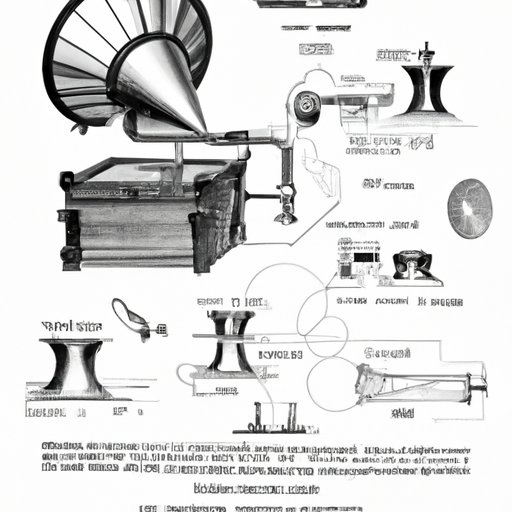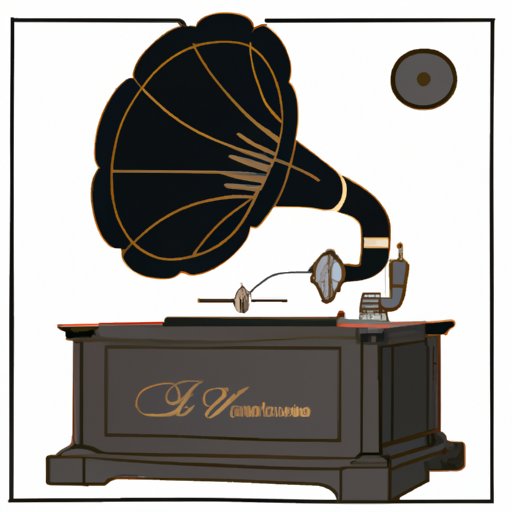Introduction
The invention of the phonograph has revolutionized music, society, and culture. But who was the genius behind this groundbreaking invention? The answer is Thomas Edison – an American inventor and businessman known for his inventions in the fields of electricity, communication, and sound recording. In this article, we will take a look at the life of Thomas Edison and explore how his invention of the phonograph changed music, society, and culture.
A Biographical Feature on Thomas Edison, The Inventor of the Phonograph
Thomas Edison was born on February 11, 1847 in Milan, Ohio. He was the seventh and last child of Samuel and Nancy Edison. From a young age, Edison was inquisitive and had an aptitude for tinkering with machines. He was homeschooled by his mother until the age of twelve and then attended public school for a short period of time.
Edison began his career as a telegraph operator at the age of sixteen and went on to become one of the most prolific inventors of all time. He is credited with over 1,000 patents in the United States alone. Among his many inventions, Edison is best known for inventing the phonograph in 1877. The phonograph was the first machine ever invented that could record and reproduce sound.
Edison’s invention of the phonograph was revolutionary, as it allowed people to record and playback sound for the first time. This opened up a wide range of possibilities in terms of music production and distribution. The phonograph changed the way people consumed music and influenced the development of new genres and styles of music.

Exploring the History of the Phonograph from Invention to Present Day
Edison’s invention of the phonograph was a watershed moment in music history. The earliest version of the phonograph used a sheet of tinfoil wrapped around a cylinder to record sound vibrations. This primitive device was capable of recording and playing back sound. However, the quality of sound was not very good due to the limitations of the technology at the time.
Over the years, the technology behind the phonograph has evolved significantly. Improvements in the design of the phonograph have resulted in better sound quality and more efficient recording and playback. Today, the phonograph is still widely used in both professional and amateur settings. It is used to record and playback music, spoken word recordings, and other sounds.

How Thomas Edison Revolutionized Music with the Invention of the Phonograph
Before the invention of the phonograph, music was primarily created and experienced through live performances. But with the introduction of the phonograph, music could be recorded and played back for others to hear. This allowed artists to create music that could be enjoyed by people outside of their immediate vicinity. As a result, music became more accessible and available to a wider audience.
The phonograph also enabled musicians to experiment with different sounds and techniques. For example, it allowed them to layer multiple tracks together and create complex musical compositions. This paved the way for the development of new musical genres such as jazz, rock, and hip-hop, which would not have been possible without the invention of the phonograph.
“The phonograph gave musicians a powerful tool to create a new kind of music,” said Dr. Matthew Jones, professor of musicology at Harvard University. “It allowed them to explore different sounds and develop new styles of music that weren’t possible before.”
Examining the Impact of the Phonograph on Music, Society, and Culture
The invention of the phonograph had a profound effect on music, society, and culture. Before the phonograph, music was primarily experienced through live performances. With the introduction of the phonograph, music became accessible to anyone with access to a phonograph. This made music more widely available and helped to spread different musical styles and genres across the world.
The phonograph also had an impact on society and culture. It allowed people to record speeches, lectures, and other important events, which were then shared with a wider audience. It also enabled people to share their thoughts and ideas with others in a way that was not previously possible. This had a huge impact on society, as it made it easier to disseminate information and educate people about different topics.

An Analysis of the Technical Aspects Behind the Invention of the Phonograph
The phonograph was a complex machine that relied on several components to work properly. At its core, the phonograph consisted of a diaphragm, a stylus, and a cylinder. The diaphragm was a thin membrane that vibrated when sound waves hit it. The stylus was a needle that was attached to the diaphragm and picked up the vibrations. Finally, the cylinder was a metal or wax cylinder that was used to record the sound vibrations.
When the diaphragm vibrated, the stylus would pick up the vibrations and etch them into the cylinder. To play back the recording, the stylus would be placed back onto the cylinder and the vibrations would be read and amplified through a speaker. This process allowed the phonograph to record and playback sound for the first time.
A Look at the Many Variations of the Phonograph Throughout History
Since its invention, the phonograph has gone through several iterations and variations. In the early days, the phonograph used a cylinder to record and playback sound. Over time, this was replaced with discs and later cassettes and CDs. Each of these formats had its own advantages and disadvantages, but all of them allowed for improved sound quality and easier playback.
In recent years, digital audio formats such as MP3s and streaming services have become increasingly popular. These digital formats offer even better sound quality and convenience than traditional phonographs. Despite this, the phonograph remains a popular choice among audiophiles and music lovers due to its superior sound quality.
A Discussion of the Different Uses of the Phonograph Over the Years
The phonograph has been used for a variety of purposes throughout its history. Initially, it was used mainly for recording and sharing music. But over the years, it has been used for a variety of other applications such as recording speeches, lectures, and other important events. Additionally, it has been used to record sound effects for movies, radio shows, and television programs.
Today, the phonograph is still widely used for recording and playback purposes. It is used in both professional and amateur settings, and can be found in recording studios, radio stations, and even home studios. Additionally, some modern phonographs are capable of digitizing recordings, which makes them ideal for archiving and preserving old recordings.
Conclusion
The invention of the phonograph by Thomas Edison revolutionized music, society, and culture. It enabled people to record and playback sound for the first time, making music more accessible and widely available. It also allowed musicians to experiment with different sounds and techniques and paved the way for the development of new musical genres. Furthermore, the phonograph has been used for a variety of purposes throughout its history, from recording speeches and lectures to creating sound effects for movies and television shows. All in all, the invention of the phonograph has had a lasting impact on music, society, and culture.
(Note: Is this article not meeting your expectations? Do you have knowledge or insights to share? Unlock new opportunities and expand your reach by joining our authors team. Click Registration to join us and share your expertise with our readers.)
